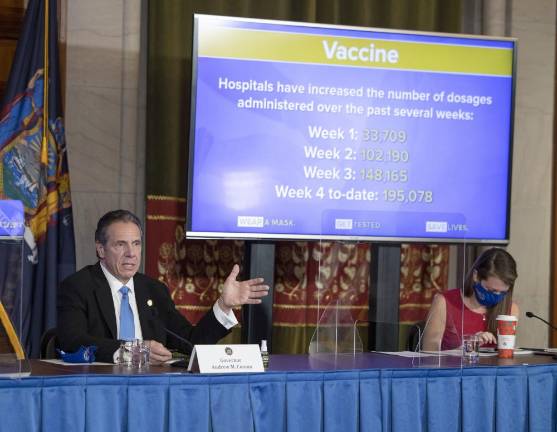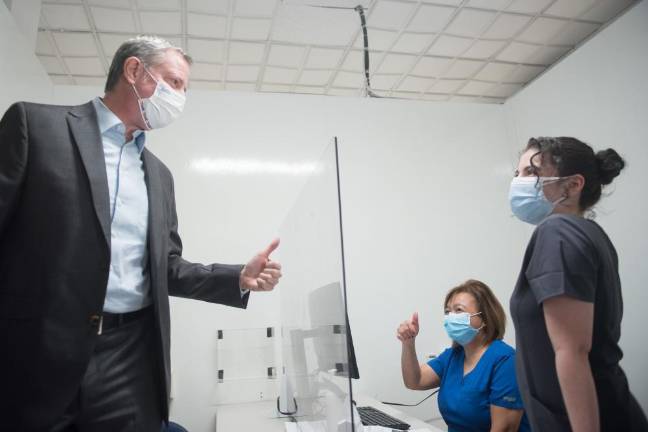Widening the Vaccine Pool
After a spat between the mayor and the governor over lagging distribution, Cuomo expands the eligibility list


This may be hard to believe, but Mayor Bill de Blasio has accused Governor Andrew Cuomo of being too controlling.
The mayor offered this insight as explanation – or perhaps excuse – as the city’s vaccination effort against COVID-19 lagged far behind what was hoped for. A lack of urgency, is how the governor described the city’s efforts.
This latest spat differs from their standard sibling-style rivalry, however, in that each was representing a view in a national, even global, argument about how to distribute still scarce vaccine fairly as well as smartly to curb the resurgent pandemic.
De Blasio said that the governor was adhering too rigidly to the priorities drawn up before the vaccine arrived.
At first, the governor not only resisted, but doubled down, threatening hospitals who didn’t quickly use their vaccine supplies as instructed with fines and expulsion from the distribution. This name-and-shame tactic did not go over well, and by Friday afternoon the governor announced that beginning Monday a new and far larger group would be invited to be vaccinated.
In this group, labeled 1B, are most public employees, including teachers, police officers and transit workers, as well as anyone 75 or older. Group 1A was limited to health workers and residents of senior care facilities.
In the 27 days since a nurse in Queens received the first dose of vaccine, 185,760 people have been vaccinated in the city as of Saturday, including 17,421 who have received both their first dose and their second “booster” dose required by both the Pfizer/BioNTech and Moderna vaccines. These vaccinations have used less than half of the 524,425 doses the city has already received and stored in various hospital refrigerators.
Pressure to Move Faster
The image of lifesaving vaccine sitting unused in refrigerators has ramped up the pressure on the mayor and the governor –indeed, on mayors and governors across the country – to move faster.
There is an instinctive tendency to say the faster the better.
Certainly faster is better than slower, if those are the only choices. But if faster means jabbing the most readily available arms, say in wealthy Manhattan neighborhoods with lots of medical services, then slowing down could be smart to get more vaccine to, say, Queens neighborhoods where the virus is more prevalent.
In other words, social equity and smart public health go together. Obviously, the best solution of all is reaching everyone swiftly.
Which is essentially the challenge New York and many communities are trying to fix right now.
One reason that many states are expanding the eligibility list is that a surprising number of health workers in category 1A have not signed up for the vaccine or outright refused it. The Fire Department told the New York Post Friday that 4,700 firefighters and FDNY’s ambulance workers, 30 percent of the department, have declined the vaccine.
This high refusal rate has left doses unused and many hospitals and clinics have had trouble quickly locating eligible recipients, sometimes making less than ideal choices. “Yes, it’s true, hospitals’ excess doses should have gone to elderly patients ahead of young, healthy workers,” said the chair of the City Council Health Committee, Mark D. Levine. “But the biggest scandal in vaccination now is not that the wrong people are getting shots. It’s that too few people are getting shots at all.”
Widening the pool, as the governor did Friday, will help. In announcing his decision, he pushed some of the responsibility for equitably administering vaccines down on public employee unions which represent many of those in group 1B.
The teachers’ unions, for example, should be “thinking about” the importance of “prioritizing older teachers, teachers in classrooms, teachers in communities with higher infection rates,” Cuomo said.
Fragmented System
Levine said another obstacle to accelerating vaccination is the fragmented system for making an appointment once you are eligible. The city’s Health + Hospitals has a separate system from the Department of Health and Mental Hygiene, which is separate from various community clinics and even the Long Island City location of Costco, which is offering vaccinations, Levine noted.
“We need one unified scheduling system for all of NYC,” he urged.
Vaccine sites are being expanded. Cuomo said the Javits Convention Center, a field hospital earlier in the pandemic, would be brought back to service as a drive-through vaccination center. On Sunday the city opened two sites – one at the Brooklyn Army Terminal in Sunset Park and the other at the Bathgate Contract Postal Station in the Bronx. Both will operate 24/7 beginning Monday. Appointments will be required and can be made by phone or online, the city said.
There is an imminent change that will affect all of this, but how is not yet clear. President-elect Joe Biden takes office Wednesday, January 20, on a promise to administer 100 million vaccine doses in his first hundred days. He has promised more money to states and local governments to distribute the vaccine and also plans to immediately release millions of doses the federal government is holding in reserve to be sure there is supply for the second doses.
Whether this turns out to be a good idea will hinge on whether Biden can find ways to keep the vaccine supply flowing from the drug makers so second doses still arrive and on whether he creates a real expansion of both staff and locations to administer the vaccine.
Biden said he has been in touch with the NFL to see if football stadiums can be made available. Since New York City’s football stadium is actually in a swamp in New Jersey this could be of limited value in the city. But both of New York’s professional baseball stadiums are nearby neighborhoods in the Bronx and Queens hardest hit by the pandemic.
“The biggest scandal in vaccination now is not that the wrong people are getting shots. It’s that too few people are getting shots at all.” Council Member Mark D. Levine